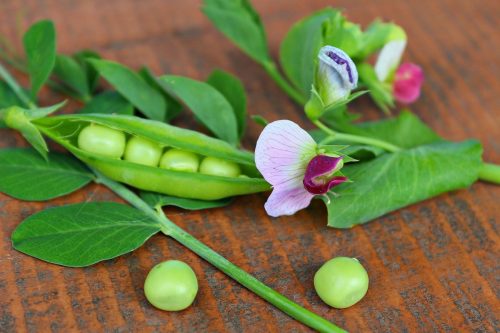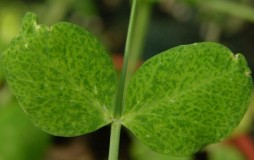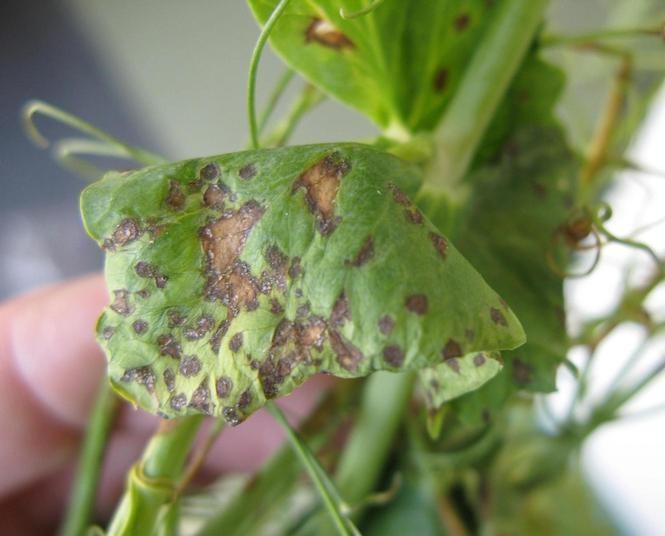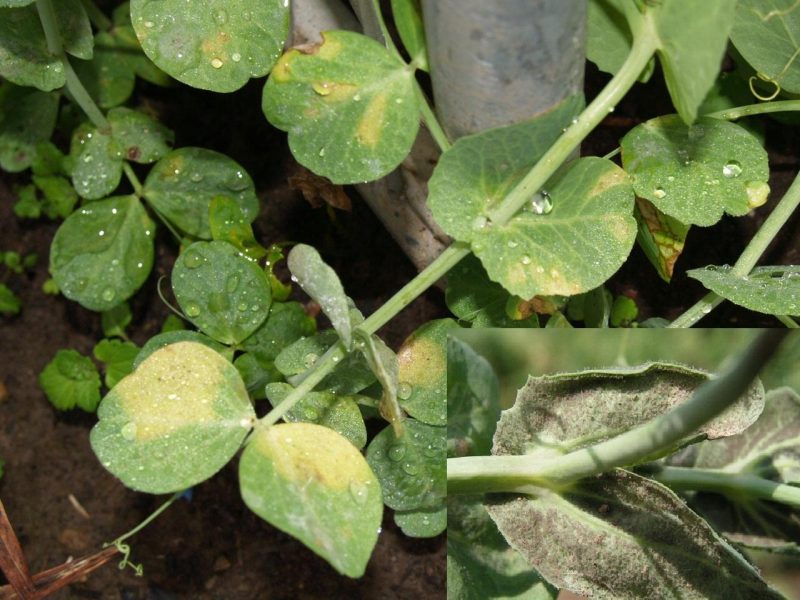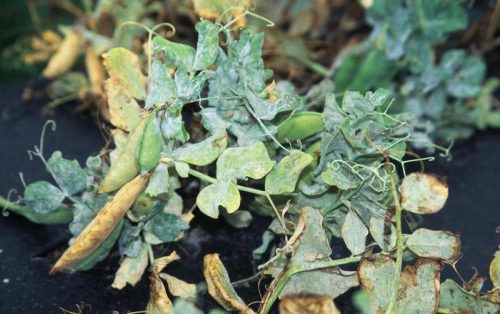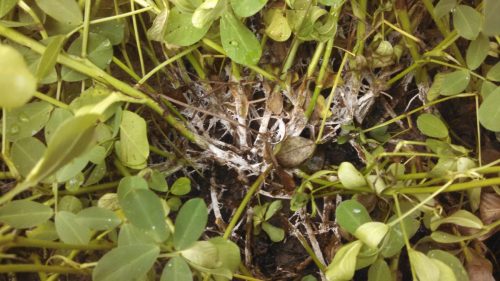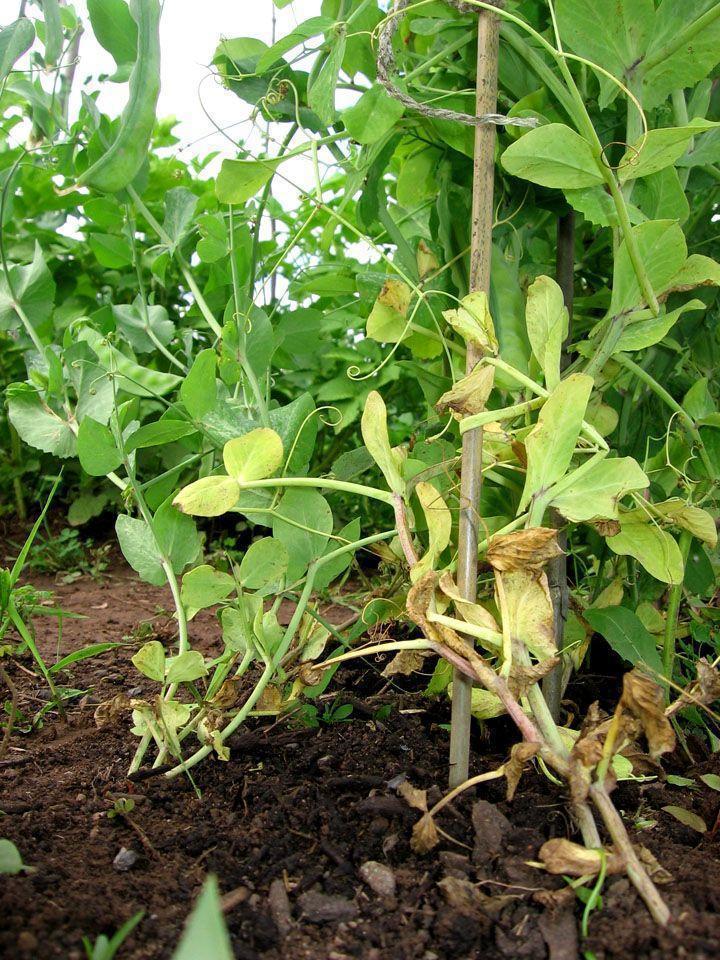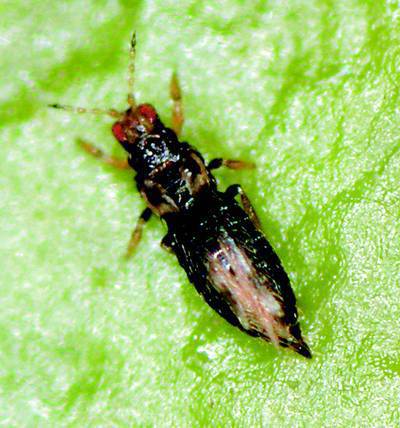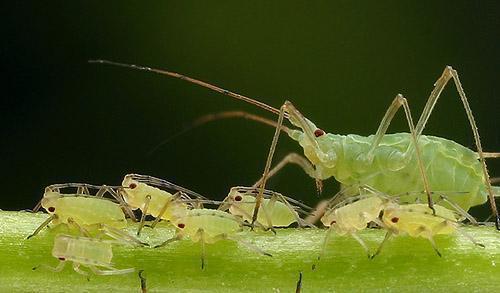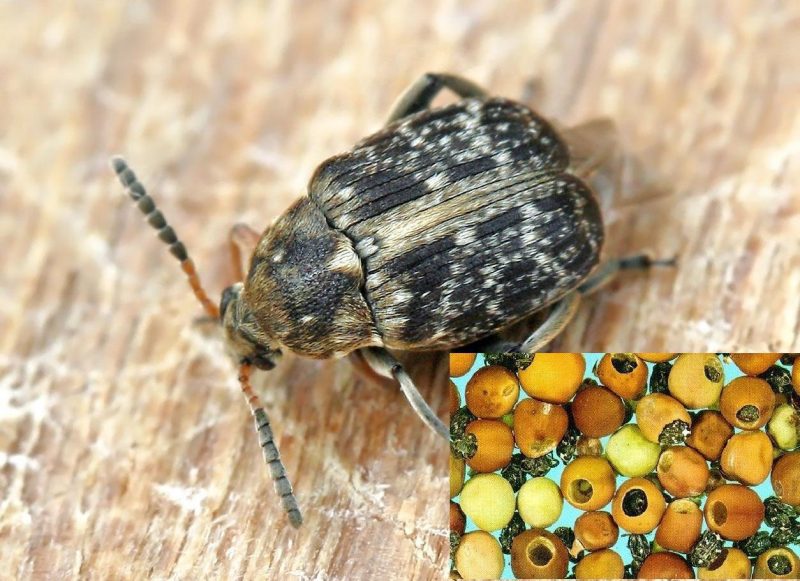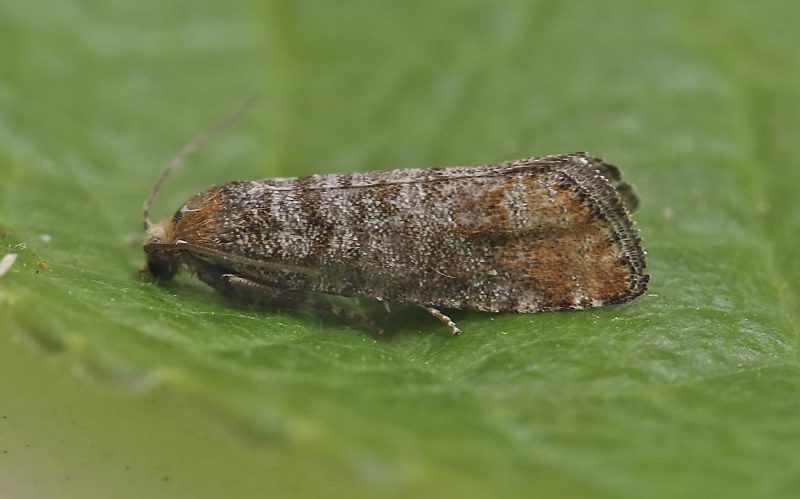Peas, treatments against pests and diseases
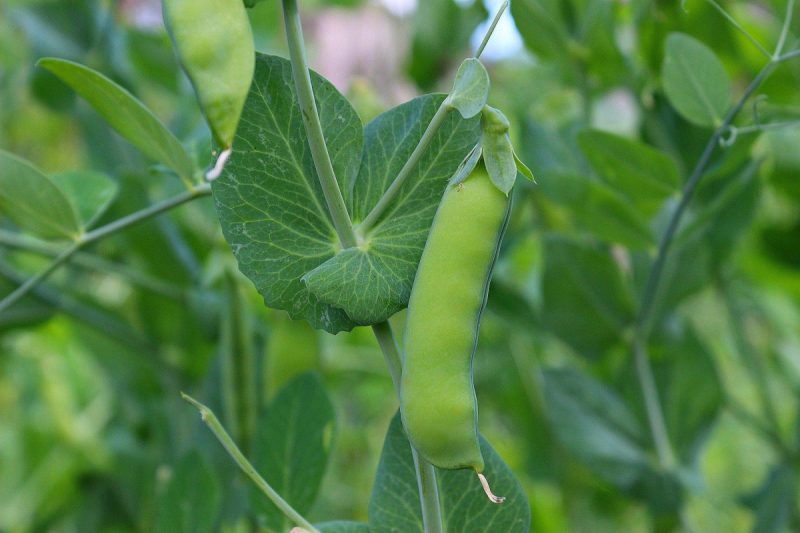
Pea (Pisum sativum) is an annual herbaceous plant, part of the Fabaceae family. It is cultivated for its green seeds, which are used to prepare various culinary specialties. Pea is native to Central Asia and the Near East. It contains lipids, sodium, potassium, carbohydrates, proteins, calcium, iron, magnesium, and vitamins (A, D, C, B-12, B6). Pea stalks obtained after harvest is good animal feed, due to their high protein content. Peas can also be used as green manure because they enrich the soil with nitrogen. The peas crop can be affected by pests and diseases, against which it’s important to apply the right treatments.
The main diseases of peas
Viruses
Pea enation mosaic virus
Dark green stripes with light green shades can be seen on the affected leaves. These spots give the leaf a mosaic appearance. The infested plants are dwarfed, heavily branched and the leaves are small and curled. The virus has a wide host circle. These are beans, lentils, lupins, and peas.
Prevention and control measures:
- spatial isolation from other legume crops;
- growing resistant pea varieties;
- applying insecticides to keep the aphid population under control.
BACTERIOSIS
Bacterial pea blight (Pseudomonas syringae pv. pisi)
Small, moist, colored spots appear on the basal leaves. On the stems these elongated spots merge to form brown stripes. Early infections may cause the flowers or first pods to dry out. Late infections lead to circular or irregular patches on the pods, which remain dry after the attack. Bacterial ooze appears on all affected areas (in wet weather), as a yellowish mucilaginous droplet. Transmission is ensured by vectors (water, air, people, machinery, etc.), which carry the bacterial ooze to other plants. The bacterium is transmitted from year to year by infected seed.
Prevention and control measures:
- growing resistant pea varieties;
- using healthy seeds;
- chemical peas treatments with specific fungicides.
Mycosis
Pea downy mildew (Peronospora pisi)
The disease manifests itself on the basal leaves, where yellowish spots appear on the upper part of the leaves. A greyish fuzz forms on the underside of the leaf. The affected tissues become necrotic and the leaves dry out. Similar spots also appear on the pods. In case of strong attacks, the infection can also affect the seeds.
Prevention and control measures:
- growing resistant varieties and hybrids;
- correct crop rotation;
- avoiding sprinkler irrigation;
- chemical peas treatments with specific fungicides.
Recommended products
-
You can find products on a different store
Change Store -
You can find products on a different store
Change Store -
You can find products on a different store
Change Store -
You can find products on a different store
Change Store -
You can find products on a different store
Change Store -
You can find products on a different store
Change Store -
You can find products on a different store
Change Store -
You can find products on a different store
Change Store -
You can find products on a different store
Change Store -
You can find products on a different store
Change Store -
You can find products on a different store
Change Store -
You can find products on a different store
Change Store -
You can find products on a different store
Change Store -
You can find products on a different store
Change Store -
You can find products on a different store
Change Store -
You can find products on a different store
Change Store -
You can find products on a different store
Change Store -
You can find products on a different store
Change Store -
You can find products on a different store
Change Store -
You can find products on a different store
Change Store -
You can find products on a different store
Change Store -
You can find products on a different store
Change Store -
You can find products on a different store
Change Store -
You can find products on a different store
Change Store
Pea powdery mildew (Erysiphe pisi)
Pea powdery mildew manifests on all plant’s organs, by the appearance of a thin, white layer. The disease progresses, then the layer becomes dusty and greyish, and the affected tissues become necrotic.
Prevention and control measures:
- correct crop rotation;
- destroying plant debris, after harvest;
- chemical peas treatments with specific fungicides.
Recommended products
-
You can find products on a different store
Change Store -
You can find products on a different store
Change Store -
You can find products on a different store
Change Store -
You can find products on a different store
Change Store -
You can find products on a different store
Change Store -
You can find products on a different store
Change Store -
You can find products on a different store
Change Store -
You can find products on a different store
Change Store -
You can find products on a different store
Change Store -
You can find products on a different store
Change Store -
You can find products on a different store
Change Store -
You can find products on a different store
Change Store -
You can find products on a different store
Change Store -
You can find products on a different store
Change Store -
You can find products on a different store
Change Store -
You can find products on a different store
Change Store -
You can find products on a different store
Change Store -
You can find products on a different store
Change Store -
You can find products on a different store
Change Store -
You can find products on a different store
Change Store -
You can find products on a different store
Change Store -
You can find products on a different store
Change Store -
You can find products on a different store
Change Store -
You can find products on a different store
Change Store
Ascochyta blight (Didymella pinodes)
Brown spots appear on the leaves and small black dots appear in the center. Similar spots appear on the pods, and the affected tissues are sunken and surrounded by a dark edge. Attacked seeds show brownish spots and the tegument is shrivelled. The disease can also occur on stems.
Prevention and control measures:
- correct crop rotation;
- gathering plant debris after harvest;
- using healthy seeds;
- chemical treatments with specific fungicides.
Recommended products
-
You can find products on a different store
Change Store -
You can find products on a different store
Change Store -
You can find products on a different store
Change Store -
You can find products on a different store
Change Store -
You can find products on a different store
Change Store -
You can find products on a different store
Change Store -
You can find products on a different store
Change Store -
You can find products on a different store
Change Store -
You can find products on a different store
Change Store -
You can find products on a different store
Change Store -
You can find products on a different store
Change Store -
You can find products on a different store
Change Store -
You can find products on a different store
Change Store -
You can find products on a different store
Change Store -
You can find products on a different store
Change Store -
You can find products on a different store
Change Store -
You can find products on a different store
Change Store -
You can find products on a different store
Change Store -
You can find products on a different store
Change Store -
You can find products on a different store
Change Store -
You can find products on a different store
Change Store -
You can find products on a different store
Change Store -
You can find products on a different store
Change Store -
You can find products on a different store
Change Store
White mold (Sclerotinia sclerotiorum)
Irregular, soft, moist spots appear on the stems and spread to the branches and leaves. Soft, moist lesions appear on the pods, which merge and destroy them. The disease progresses gradually and a white fuzz develops on the affected spots, representing the fungus fructifications.
Prevention and control measures:
- correct crop rotation;
- gathering and destroying plant debris after harvest;
- removing affected plants from the crop;
- avoiding sprinkler irrigation;
- balanced fertilization;
- chemical treatments with specific fungicides.
Gray mold (Botrytis cinerea)
The attack manifests itself on all aerial organs of the plant. Circular, yellowish spots appear on the leaf blade, then turn brown. On the pods, the attack appears as a wet rot. It appears first on the tops of the pods. As the disease progresses, a greyish mycelium develops on the attacked organs.
Prevention and control measures:
- removing affected plants from the crop;
- avoiding sprinkler irrigation;
- balanced fertilization;
- chemical treatments during the growing season with specific fungicides.
Recommended products
-
You can find products on a different store
Change Store -
You can find products on a different store
Change Store -
You can find products on a different store
Change Store -
You can find products on a different store
Change Store -
You can find products on a different store
Change Store -
You can find products on a different store
Change Store -
You can find products on a different store
Change Store -
You can find products on a different store
Change Store -
You can find products on a different store
Change Store -
You can find products on a different store
Change Store -
You can find products on a different store
Change Store -
You can find products on a different store
Change Store -
You can find products on a different store
Change Store -
You can find products on a different store
Change Store -
You can find products on a different store
Change Store -
You can find products on a different store
Change Store -
You can find products on a different store
Change Store -
You can find products on a different store
Change Store -
You can find products on a different store
Change Store -
You can find products on a different store
Change Store -
You can find products on a different store
Change Store -
You can find products on a different store
Change Store -
You can find products on a different store
Change Store -
You can find products on a different store
Change Store
Fusarium wilt (Fusarium oxysporum)
The first symptoms include basal leaf wilting. The disease progresses and the whole plant wilts. In the stem section, browned vessels can be seen. From place to place, on the stem surface, a white growth forms, representing the fungus fructifications.
Prevention and control measures:
- correct crop rotation;
- gathering and destroying infected debris;
- weed control;
- chemical treatments with specific fungicides.
The main pea pests
Thrips
They are small pests, difficult to see with the naked eye, which attack many species of vegetables. They colonize the growth tips, flowers, and leaves, causing flower abortion and dwarfing.
Control methods:
- using sticky traps;
- specific insecticide treatments.
Aphids
They are polyphagous species that migrate from one plant to another or from one species to another. Aphids grow on spontaneous flora and then move on to cultivated species. They appear as a colony on the underside of leaves, flowers or inflorescences, and young shoots. Insects sting and suck the sap, stressing the plant. In case of a severe attack, it can lead to plant death.
Control methods:
- using sticky traps;
- specific insecticide treatments.
Recommended products
-
You can find products on a different store
Change Store -
You can find products on a different store
Change Store -
You can find products on a different store
Change Store -
You can find products on a different store
Change Store -
You can find products on a different store
Change Store -
You can find products on a different store
Change Store -
You can find products on a different store
Change Store -
You can find products on a different store
Change Store -
You can find products on a different store
Change Store -
You can find products on a different store
Change Store -
You can find products on a different store
Change Store -
You can find products on a different store
Change Store -
You can find products on a different store
Change Store -
You can find products on a different store
Change Store -
You can find products on a different store
Change Store -
You can find products on a different store
Change Store -
You can find products on a different store
Change Store -
You can find products on a different store
Change Store -
You can find products on a different store
Change Store -
You can find products on a different store
Change Store -
You can find products on a different store
Change Store -
You can find products on a different store
Change Store -
You can find products on a different store
Change Store -
You can find products on a different store
Change Store
Pea weevil (Bruchus pisorum)
It develops one generation per year and overwinters as an adult in sheds, in infested seeds, and cracks in walls and floors. The species is considered monophagous, the larvae gnaw inside the seeds, consuming up to 40-50% of the seed mass. Adults feed on pollen and do not cause significant damage.
Control methods:
- vegetation treatments with specific insecticides.
Pea Moth (Cydia nigricana)
It has one generation per year and overwinters as a fully-grown larva in a silky cocoon in the soil. It mainly attacks peas, but can also attack other legume species. The larvae gnaw the seed irregularly. One larva can attack up to four seeds. In the pods, you can see silky threads and larvae droppings, which depreciate the crop quality.
Control methods:
- chemical treatments with specific insecticides.














































































































































































































































































































































































































































